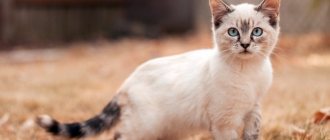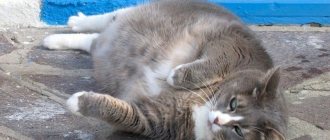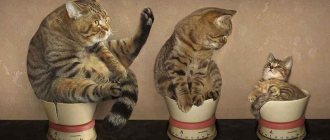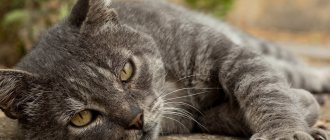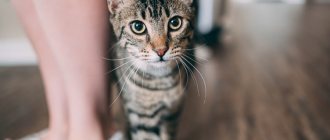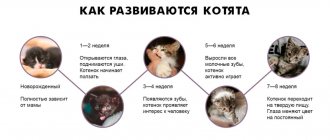Pets live incomparably less than people, but go through the same age stages - from infancy to old age. And the owner, striving for complete understanding with the animal, often wants to know how old the cat is by human standards.
Using the online calculator on our website, it is very easy to obtain this information. Let's take a closer look at the principles of its operation and draw a parallel in the development of cats and people.
Comparison of the age periods of a cat and a person
Like the life of humans, the development of cats can be divided into 6 age stages.
Infancy
This period begins at birth and lasts up to about a month. The kitten grows quickly and learns to interact with the world around it. By 4 weeks, all his senses are working perfectly, and his baby teeth are erupting.
On a note. A one-month-old kitten can be compared to a 1.5-year-old child.
Childhood
Kittens remain in the status of children for up to six months. By analogy with a person, 6 cat months are 10 years. The starting point for the next period is the replacement of baby teeth with molars.
Teenage years
Puberty and the final formation of the cat’s body occur at this stage. It is completed by 1.5-2 years.
Youth
The prime age of a cat's life is from 2 to 5 years. At this time, animals are most active, rarely get sick, and are ready to mate and bear full-fledged offspring.
Maturity
A mature cat is between 6 and 10 years old. With proper care, it is difficult to distinguish it from a young one, but age-related changes are already noticeable - gray hair, grinding of teeth, etc. After 7 years, it is not advisable to use pets for breeding.
Old age
This category includes animals from 11 to 14 years old. Their activity decreases, they may develop diseases, decrease visual acuity, hearing, loss of teeth, etc. Cats that have passed the 15-year mark become long-livers.
What is the average life expectancy of cats?
In the wild, animals live a maximum of 5–7 years.
At home, life expectancy is significantly longer and averages from 13 to 18 years. True, there are also centenarians who are happy to celebrate their 20th anniversary.
Stages of life
The life of a pet goes through several stages:
- childhood . Ends at six months of age;
- youth _ The period lasts from six months to two years. Puberty occurs and changes in behavior are noted. Already at the age of one and a half years, a cat can give birth;
- youth . The stage lasts from two to five years. The blossoming of strength is noted. The pet is active and full of energy;
- maturity _ Lasts until the age of ten. The pet continues to remain active, but reacts more calmly to everything that surrounds it;
- pension and old age . Occurs between 11 and 15 years of age. The animal already requires special care. He is calm, less active. There is a deterioration in the condition of the coat.
Stages of life
A table of cat ages according to human standards (in years) will help you better understand how your pet feels and what stage of life it is at.
| Age of the cat | Person's age |
| 1 | 15 |
| 2 | 24 |
| 3 | 29-33 |
| 4 | 34-36 |
| 5 | 37-40 |
| 6 | 41-45 |
| 7 | 46-47 |
| 8 | 50-52 |
| 9 | 55-56 |
| 10 | 60-62 |
| 11 | 64-65 |
| 12 | 67-68 |
| 13 | 70 |
| 14 | 72-73 |
| 15 | 75 |
| 16 | 76-77 |
| 17 | 78 |
| 18 | 83-84 |
| 19 | 90-91 |
| 20 | 100 |
For your information. The table shows approximate data. Even representatives of the same breed develop differently, and it is not possible to derive an exact translation formula.
Existing calculation methods
Calculations can be made in different ways. It is worth considering the most common of them.
Method 1
The simplest method is considered to be a ratio of cat to human age of 1:7. It is enough to simply multiply the pet’s age by seven and thus you will be able to get its human analogue.
As a result, it turns out that at one year a kitten is a child going to first grade. By the age of three he should have graduated from college. By the age of seven, the animal has already reached adulthood.
True, this method of calculation is not entirely correct. After all, a cat develops differently than a human. For example, in the first year her development is more rapid than that of seven-year-old children. By this period, the pet has already become sexually mature.
Method 2
According to the second method, the first year of an animal’s life is equivalent to 15 human years. By the age of two, the pet is already 24 by human standards. In the future, every year you need to add 4. In this case, the calculations will be more accurate.
How to determine the age of a cat by external signs
If the cat's age is unknown, you should carefully examine it and observe its behavior. The approximate number of years lived is revealed by the eyes, teeth, condition of the skeleton, coat and other signs.
By the eyes
A healthy and young animal has a richly colored iris with clear contours. With age, irregularities and inclusions appear on it, the color fades, and the edges blur.
Older cats' eyes become cloudy. However, whitish spots can be a symptom of cataracts, which sometimes affects young animals. The same goes for increased tear production. It can indicate both old age and the presence of pathology.
Tough
You can also roughly determine the age of a cat based on the condition of its teeth:
- 26 primary teeth erupt from the 2nd to the 6th week after birth;
- the change to primary ones takes place from 3 to 6 (rarely up to 9) months;
- a one-year-old cat has 30 white teeth without plaque or signs of wear;
- at 2 years of age, slight yellowing of the enamel becomes noticeable if cleaning is not carried out regularly;
- by the age of 3, the middle incisors begin to wear off, by the age of 4 – the central ones;
- in 5-year-old cats, a yellow coating is clearly visible; after another year, the outer incisors and canines are clearly worn down;
- In the future, the teeth continue to wear out; after 10 years, the incisors and then the canines may fall out.
On a note. Adjustments should be made for care and genetic factors. Some animals have teeth that remain strong and healthy into old age.
According to the condition of the musculoskeletal system
Another way to lift the veil of mystery about a cat’s age is to assess the condition of its musculoskeletal system:
- one-month-old kittens are disproportionately built - they have a large head, but short and weak legs;
- in adolescents, on the contrary, the limbs look excessively long and the ears large;
- after the end of puberty, the cat acquires developed muscles, moves easily and gracefully, and jumps high;
- Signs of aging appear by the age of 7-8: the spine “sinks,” the shoulder blades protrude, the gait becomes heavier, and the volume of the body decreases due to a reduction in the number of muscles.
Older cats may develop arthritis, arthrosis and other diseases.
By other external signs
You can get a rough idea of the age of a cat by other signs:
- Wool. In kittens it is soft and silky. With age it becomes a little tougher, with a clear pattern. After 8 years, gray hair appears, sometimes tangles due to severe coarsening.
- Behavior. Kittens and “youth” are usually active and playful. Mature pets prefer to rest more, while older pets have a hard time with any activity.
These criteria should be taken into account in conjunction with other signs. Then you will be able to determine the cat’s age more accurately.
How to extend the life of a pet
A cat's age in human terms is not so fleeting. However, a loving owner always wants his ward to live as long as possible. What depends on the pet owner? You might be surprised, but a lot!
- Follow the recommendations of veterinarians and breeders regarding housing conditions and nutrition (for each individual breed).
- Get vaccinated.
- Do not forget about anthelmintic and disinfectant measures.
- Take your pet out into the fresh air and play with him.
- Never punish your pet for pranks, but teach him to use the tray and scratching post from childhood.
- Provide timely assistance if necessary (injuries, diseases, allergic reactions, pathologies of any etiology).
Important! Do not self-medicate, but seek help from a public veterinary hospital or private clinic. Take a responsible approach to keeping your pet, show affection and care, and then he will delight you and other household members with his presence for many years
Take a responsible approach to keeping your pet, show affection and care, and then he will delight you and other household members with his presence for many years.
How to calculate a cat's age in human years?
There are many ways, and expert opinions often vary greatly. There is the simplest and most well-known way to find out age: count each cat year as seven human years. Using this method, you can roughly imagine how ancient an old lady you just threw a slipper at.
This seemingly simple and easy calculation option, alas, is far from ideal: it is inaccurate and gives only an approximate result. After all, even people develop unevenly throughout their lives, what can we say about creatures such as cats?
How to determine more precisely?
Feline scientists have been researching this issue for many years and managed to create a table that shows the relationship between the stages of cat development relative to human ones. Using this calculator, you can more accurately calculate the human age of an animal.
When examining the data in the table, it becomes clear that in the first year of its life, a cat learns about the same amount about itself as a human cub does in its fifteen years. Only the second year has passed, and your cat will definitely be sold alcohol and allowed into the club - after all, consider 24. After the second year, development slows down, there is nowhere to rush, it makes sense to enjoy youth and activity.
Each subsequent new year adds only 4 years to your pet’s internal age. Thus, a sixteen-year-old cat is already an eighty-year-old old lady.
How is a cat's age calculated by human standards?
Now that it is clear how to calculate the age of your pet, you can see that such a table is far from the only one. Instead of simple numbers, it is much more interesting to divide a pet’s life into stages, like a person’s: infancy, childhood, teenage crisis, youth, maturity, old age. But seriously, scientists have already divided it, and there are 6 such stages.
Is it possible to increase the lifespan of a cat?
Any owner dreams of having a furry family member to please him for as long as possible. And he has the power to do everything so that the cat lives for 15, or even 20 years. What will prolong the life of your beloved four-legged animal:
- Annual vaccination
. The kitten is vaccinated in the first 2-3 months of life and then the procedure is repeated every year. This will protect both your indoor and outdoor cats from the most terrible viruses with a high fatality rate.
- Routine examination by a veterinarian
. Non-pedigreed cats get sick less, so they can be shown to the veterinarian during vaccination once a year - just ask the doctor about this. Pedigree animals and animals with chronic diseases require more frequent visits to the veterinary clinic - the frequency will be determined by the veterinarian himself.
- Sterilization and castration
. If you do not plan to breed kittens, be sure to sterilize your pet - this will help avoid many problems, including diseases of the genitourinary system and mental disorders.
- Attention to any changes in your pet's behavior
. Has your cat started drinking a lot? Stopped sleeping in your favorite chair? Is he limping? Are there strange discharges? Even such little things require close attention from the owner. The first action in case of suspicion is to call the veterinarian, he will tell you whether you need to take the animal to the clinic or if you can watch it at home.
- Purity
- the key to health. Cats groom themselves, but this is not enough to maintain hygiene. For example, long-haired breeds cannot cope with caring for a luxurious fur coat, and it must be combed regularly to prevent parasites or skin diseases. It is necessary to thoroughly rinse the cat's food and water bowls, disinfect the trays, and wash the bedding.
- Nutrition
must be maintained at a high level. It is not so important what you feed your cat - the main thing is that the selected diet suits it. A young cat will benefit from both natural food and high-quality dry food. But kittens and elderly individuals require a special menu, which cannot be cheap. Therefore, before getting a cat, think about the fact that in old age, in 95% of cases, it will require greater expenses than in youth.
- Treat your cat like a family member
. Consider the nature of the pet and its needs. If she doesn't tolerate loneliness well, you shouldn't leave her in the apartment all day. And on the contrary - if the kitty loves isolation, respect her personal space. There are many such points, and if you do not pay attention to the psychological state of the animal, it will constantly be sick and will not live very long.
This is not a complete list of what a loving owner can do. The most important thing is to be attentive and patient, treating your pet as a younger member of the family. Then he will live very long and happily.
Ratio table
Like people, animals go through several stages of growing up: childhood, puberty, maturity and old age. It is necessary to take into account the rate of change at a particular stage in order to find out how old a cat is by human standards. The table below details the pet's maturation:
| Life stage | Cat age | Human equivalent |
| Kitten (birth – 6 months) | 0-1 month | 0-1 year |
| 2 months | 2 years | |
| 3 months | 4 years | |
| 4 months | 6 years | |
| 5 months | 8 years | |
| 6 months | 10 years | |
| Adolescent/young (7 months – 2 years) | 7 months | 12 years |
| 12 months | 15 years | |
| 18 months | 21 g | |
| 2 g | 24 g | |
| Adult (3-6 years old) | 3 g | 28 years |
| 4 g | 32 g | |
| 5 years | 36 years | |
| 6 years | 40 years | |
| Mature (7-10 years old) | 7 years | 44 g |
| 8 years | 48 years old | |
| 9 years | 52 g | |
| 10 years | 56 years old | |
| Elderly (11-14 years old) | 11 years | 60 years |
| 12 years | 64 g | |
| 13 years | 68 years old | |
| 14 years | 72 g | |
| Very old (15 years and older) | 15 years | 76 years old |
| 16 years | 80 years old | |
| 17 years | 84 g | |
| 18 years | 88 years old | |
| 19 years | 92 g | |
| 20 years | 96 years old | |
| 21 g | 100 years | |
| 22 g | 104 g | |
| 23 g | 108 years old | |
| 24 g | 112 years | |
| 25 years | 116 years |
The calculation starts at a rate of 1 in 12, peaking at one year of age (1:15) and gradually falling to a ratio of approximately 1:4.6. It shows that the pet is a dynamic variable.
It is necessary to build on current figures in order to understand and determine how old the cat is by human standards. The table describes in detail the interspecific proportions.
Determining age by external signs
Animals are not always adopted by owners in infancy. If a person has an adult cat, an examination will help determine its age:
- Body. An animal that has survived several years on the street has dense muscles. Brownness is a sign of most homeless individuals. But the young cat has soft muscles. Years of fighting for territory form a densely built body with a minimum fat content, accumulating, if possible, in preparation for winter. In older individuals, sagging skin on the abdomen (under the arms) and protruding shoulder blades are observed.
- Teeth. A white, healthy jaw is a sign of an individual aged 1-2 years. Of course, kittens can also have dental problems. But it is possible to distinguish inflammation caused by poor nutrition from plaque that has formed over the years. The latter may not cause discomfort, but will stain the enamel dark.
- Wool. Helps to determine by touch the age of a cat by human standards. The table indicates that the pet lives more than 100 years, when translated into the owner's chronology. The older the individual, the tougher its pile. Older animals may also experience gray hair and localized baldness.
- Eyes. In young people - clear, without signs of tears or mucous discharge in the corners. Although their appearance is also facilitated by pathogens and weakened immunity. The texture of the iris is one of the ways to determine the age of a cat by human standards. In young individuals it is relatively uniform - with the exception of pigment spots or traces of injury. With age, the vessels of the organ appear. Lacrimal tracks are also formed, into which secretions caused by injuries, infections and inflammatory processes flow.
People communicate not only with pets, which they raise from infancy. Having realized that a 7-year-old cat by human standards is equal to 44 years old, they can begin to have great respect for their dacha “neighbor” who has survived another winter. Understanding the relationships will also help in communicating with your own pet.
Why know your pet's age in human equivalent?
Life expectancy depends on conditions. So, the tramp will be lucky to celebrate 9 years - the cat, by human standards from the table, will turn 52 years old. In human terms, he will not even cross retirement age. On the street, an individual risks not living to see its 5th anniversary due to: transport;
- clashes with relatives and other animals;
- poor quality nutrition;
- atmospheric phenomena.
The home offers the pet a comfortable environment. But the owner should also recalculate the cat’s age in human years. When an animal enters the elderly phase, it becomes more susceptible to:
- cancer;
- diabetes;
- cardiovascular diseases;
- problems with kidneys and other organs.
The root causes of illness are poor diet, infections, injuries or contact with pathogens, such as fungus in the bathroom. But age additionally increases the likelihood of developing diseases due to weakened immunity.
As in the case of a person celebrating his 60th birthday, an animal older than 8-10 years needs attention to its health.
If castration (sterilization) has not been performed, the individual should be checked regularly (at least once a year) for signs of genital cancer. Regular examinations are also necessary in the presence of chronic diseases.
If at 6-7 years old a pet with kidney failure had enough proper nutrition, then after the 10th anniversary it is better to periodically (1-2 times a year, in the absence of signs of inflammation) give urine for analysis. For problems with the heart and other organs, regular checks are also advisable.
You should refrain from preventive visits to the veterinarian if your pet is nervous. If an elderly individual does not show signs of illness (weakness, anxiety, refusal to eat, etc.), there is no need to expose her to unnecessary stress.
Like any animal, a cat goes through several stages of development. These stages must be taken into account when comparing a pet's age to a human's. An individual grows fastest during the period of up to 6 months. Then the speed slows down gradually, reaching a ratio of 1 cat year to 4.5-5 human years.
Knowing the proportion will help calculate the age of the animal at a specific point in time and adjust its care at different stages of development.
The table also makes you think about the pet’s quality of life. So, if we start from the “dog” variable, a 15-year-old cat corresponds to a 105-year-old person (82.5 years, if we take a multiplier of 5.5). Respectable age.
But a dynamic calculation shows that such an individual dies at 76 years of age. Not much compared to a person who has access to quality food and health care. By monitoring the health of the pet, owners can ensure its “centenary” anniversary.


